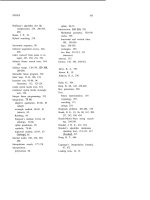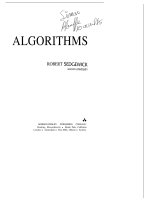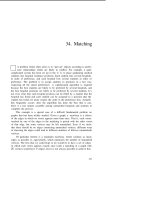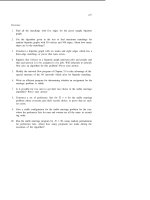Tài liệu Thuật toán Algorithms (Phần 50) ppt
Bạn đang xem bản rút gọn của tài liệu. Xem và tải ngay bản đầy đủ của tài liệu tại đây (97.1 KB, 10 trang )
37. Dynamic Programming
The principle of divide-and-conquer has guided the design of many of
the algorithms we’ve studied: to solve a large problem, break it up into
smaller problems which can be solved independently. In dynamic programming
this principle is carried to an extreme: when we don’t know exactly which
smaller problems to solve, we simply solve them all, then store the answers
away to be used later in solving larger problems.
There are two principal difficulties with the application of this technique.
First, it may not always be possible to combine the solutions of two problems
to form the solution of a larger one. Second, there may be an unacceptably
large number of small problems to solve. No one has precisely characterized
which problems can be effectively solved with dynamic programming; there are
certainly many “hard” problems for which it does not seem to be applicable
(see Chapters 39 and as well as many “easy” problems for which it is
less efficient than standard algorithms. However, there is a certain class of
problems for which dynamic programming is quite effective. We’ll see several
examples in this section. These problems involve looking for the “best” way to
do something, and they have the general property that any decision involved
in finding the best way to do a small subproblem remains a good decision even
when that subproblem is included as a piece of some larger problem.
Knapsack Problem
Suppose that a thief robbing a safe finds N items of varying size and value
that he could steal, but has only a small knapsack of capacity A4 which he
can use to carry the goods. The knapsack problem is to find the combination
of items which the thief should choose for his knapsack in order to maximize
the total take. For example, suppose that he has a knapsack of capacity 17
and the safe contains many items of each of the following sizes and values:
483
CHAPTER 37
name A B C D E
size
34789
value
4 5 10 11 13
(As before, we use single letter names for the items in the example and integer
indices in the programs, with the knowledge that more complicated names
could be translated to integers using standard searching techniques.) Then
the thief could take five A’s (but not six) for a total take of 20, or he could
fill up his knapsack with a D and an E for a total take of 24, or he could try
many other combinations.
Obviously, there are many commercial applications for which a solution
to the knapsack problem could be important. For example, a shipping com-
pany might wish to know the best way to load a truck or cargo plane with
items for shipment. In such applications, other variants to the problem might
arise: for example, there might be a limited number of each kind of item
available. Many such variants can be handled with the same approach that
we’re about to examine for solving the basic problem stated above.
In a dynamic programming solution to the knapsack problem, we calcu-
late the best combination for all knapsack sizes up to M. It turns out that we
can perform this calculation very efficiently by doing things in an appropriate
order, as in the following program:
for to do
begin
for to M do
if then
if then
begin
:=j
end
end
In this program, is the highest value that can be achieved with a
knapsack of capacity i and best [i] is the last item that was added to achieve
that maximum (this is used to recover the contents of the knapsack, as
described below). First, we calculate the best that we can do for all knapsack
sizes when only items of type A are taken, then we calculate the best that we
can do when only and B’s are taken, etc. The solution reduces to a simple
calculation for cost Suppose an item j is chosen for the knapsack: then the
best value that could be achieved for the total would be (for the item)
PROGRAMMING
485
plus cost (to fill up the rest of the knapsack). If this value exceeds
the best value that can be achieved without an item j, then we update cost [i]
and otherwise we leave them alone. A simple induction proof shows
that this strategy solves the problem.
The following table traces the computation for our example. The first
pair of lines shows the best that can be done (the contents of the cost and
best arrays) with only A’s, the second pair of lines shows the best that can be
done with only A’s and B’s, etc.:
1
2 3 4 5 6 7 8 9
1011121314151617
0 0 4 4 4 8 8 8 12
12 12 16 16 16 202020
AAAAAAAAAAAAAAA
0 0 4 5 5 8 9 10 12
13 14 16 17 18 20 21 22
ABBABBABBABBABB
0 0 4 5 5 8 10 10 12
14 15 16 18 20 20 22 24
ABBACBACCACCACC
0 0 4 5 5 8 10 11 12
14 15 16 18 20 21 22 24
ABBACDACCACCDCC
0 0 4 5 5 8 10 11 13
14 15 17 18 20 21 23 24
ABBACDECCECCDEC
Thus the highest value that can be achieved with a knapsack of size 17 is 24.
In order to compute this result, we also solved many smaller subproblems.
For example, the highest value that can be achieved with a knapsack of size
16 using only A’s B’s and C’s is 22.
The actual contents of the optimal knapsack can be computed with the
aid of the best array. By definition, best [M] is included, and the remaining
contents are the same as for the optimal knapsack of size
Therefore,
best [M-size [ best
is included, and so forth. For our example,
then we find another type C item at size 10, then a type A item
at size 3.
It is obvious from inspection of the code that the running time of this
algorithm is proportional to NM. Thus, it will be fine if M is not large,
but could become unacceptable for large capacities. In particular, a crucial
point that should not be overlooked is that the method does not work at all if
M and the sizes or values are, for example, real numbers instead of integers.
This is more than a minor annoyance: it is a fundamental difficulty. No good
solution is known for this problem, and we’ll see in Chapter 40 that many
486
37
people believe that no good solution exists. To appreciate the difficulty of the
problem, the reader might wish to try solving the case where the values are
all 1, the size of the jth item is and M is N/2.
But when capacities, sizes and values are all integers, we have the fun-
damental principle that optimal decisions, once made, do not need to be
changed. Once we know the best way to pack knapsacks of any size with the
first items, we do not need to reexamine those problems, regardless of what
the next items are. Any time this general principle can be made to work,
dynamic programming is applicable.
In this algorithm, only a small amount of information about previous
optimal decisions needs to be saved. Different dynamic programming applica-
tions have widely different requirements in this regard: we’ll see other examples
below.
Matrix Chain Product
Suppose that the six matrices
are to be multiplied together. Of course, for the multiplications to be valid,
the number of columns in one matrix must be the same as the number of rows
in the next. But the total number of scalar multiplications involved depends
on the order in which the matrices are multiplied. For example, we could
proceed from left to right: multiplying A by B, we get a 4-by-3 matrix after
using 24 scalar multiplications.
Multiplying this result by C gives a 4-by-1
matrix after 12 more scalar multiplications. Multiplying this result by D gives
a 4-by-2 matrix after 8 more scalar multiplications. Continuing in this way,
we get a 4-by-3 result after a grand total of 84 scalar multiplications. But if
we proceed from right to left instead, we get the same 4-by-3 result with only
69 scalar multiplications.
Many other orders are clearly possible. The order of multiplication can be
expressed by parenthesization: for example the order described
above is the ordering (((((A*B)*C)*D)*E)*F), and the right-to-left order is
(A*(B*(C*(D*(E*F))))). Any legal parenthesization will lead to the correct
answer, but which leads to the fewest scalar multiplications?
Very substantial savings can be achieved when large matrices are involved:
for example, if matrices B, C, and F in the example above were to each have
a dimension of 300 where their dimension is 3, then the left-to-right order
will require 6024 scalar multiplications but the right-to-left order will use an
487
astronomical 274,200. (In these calculations we’re assuming that the standard
method of matrix multiplication is used. Strassen’s or some similar method
could save some work for large matrices, but the same considerations about
the order of multiplications apply. Thus, multiplying a p-by-q matrix by
a q-by-r matrix will produce a matrix, each entry computed with
multiplications, for a total of multiplications.)
In general, suppose that N matrices are to be multiplied together:
where the matrices satisfy the constraint that has rows and columns
for 1 N. Our task is to find the order of multiplying the matrices
that minimizes the total number of multiplications used. Certainly trying
all possible orderings is impractical. (The number of orderings is a
studied combinatorial function called the Catalan number: the number of
ways to parenthesize N variables is about But it is certainly
worthwhile to expend some effort to find a good solution because N is generally
quite small compared to the number of multiplications to be done.
As above, the dynamic programming solution to this problem involves
working “bottom up,” saving computed answers to small partial problems to
avoid recomputation. First, there’s only one way to multiply by
by . . . , by MN; we record those costs. Next, we calculate the best
way to multiply successive triples, using all the information computed so far.
For example, to find the best way to multiply first we find the cost
of computing from the table that we saved and then add the cost of
multiplying that result by This total is compared with the cost of first
multiplying then multiplying by which can be computed in the
same way. The smaller of these is saved, and the same procedure followed for
all triples. Next, we calculate the best way to multiply successive groups of
four, using all the information gained so far. By continuing in this way we
eventually find the best way to multiply together all the matrices.
In general, for 1 N 1, we can find the minimum cost of computing
for 1 i N by finding, for each k between i and i + j, the cost of
computing and and then adding the cost
of multiplying these results together. Since we always break a group into two
smaller groups, the minimum costs for the two groups need only be looked
up in a table, not recomputed. In particular, if we maintain an array with
entries cost giving the minimum cost of computing then
the cost of the first group above is cost [i, k-l] and the cost of the second









